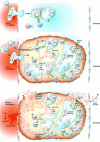Protection against tuberculosis: cytokines, T cells, and macrophages
- PMID: 12379623
- PMCID: PMC1766701
- DOI: 10.1136/ard.61.suppl_2.ii54
Protection against tuberculosis: cytokines, T cells, and macrophages
Abstract
Tuberculosis remains a major health problem, with two million deaths and eight million new cases annually. At the same time, two billion people (one third of the total world population) are infected with the aetiological agent, Mycobacterium tuberculosis. Of these, fewer than 10% ever develop disease, although the pathogen is not eradicated but rather contained in discrete lesions. Hence, the immune system is highly effective in containing the pathogen, but fails to eradicate it. Disease typically develops through reactivation once the immune system is weakened. The immune response to M tuberculosis is T cell dependent. It comprises not only the conventional CD4 and CD8 T cells, but also gammadelta T cells and CD1 restricted T cells. gammadelta T cells recognise phospholigands and no presentation molecules are known thus far. CD1 restricted T cells recognise glycolipids, which are highly abundant components of the mycobacterial cell wall. Although different T cells are required for optimum protection, the immune mechanisms known to have a role in acquired resistance can be associated with two major mechanisms: (a) activation of macrophages by cytokines; (b) direct cytolytic activity. In vivo granuloma formation, which is central to protection, is induced and sustained by cytokines. Mycobacteria are contained within granulomas and in this way are prevented from spreading all over the body.
Figures



References
Publication types
MeSH terms
Substances
LinkOut - more resources
Full Text Sources
Other Literature Sources
Medical
Research Materials

